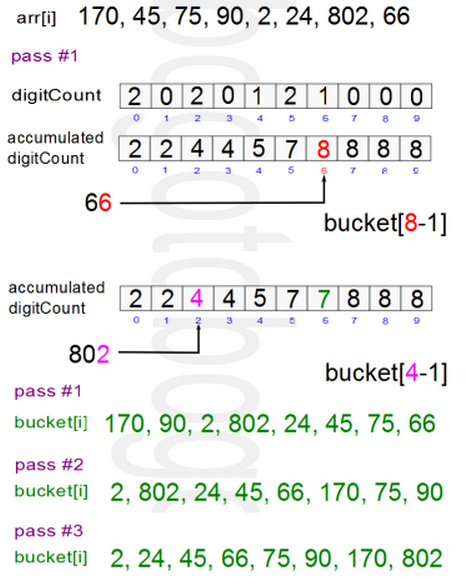基数排序与桶排序,计数排序【详解】
桶排序简单入门篇^-^
在我们生活的这个世界中到处都是被排序过的东东。站队的时候会按照身高排序,考试的名次需要按照分数排序,网上购物的时候会按照价格排序,电子邮箱中的邮件按照时间排序……总之很多东东都需要排序,可以说排序是无处不在。现在我们举个具体的例子来介绍一下排序算法。
首先出场的是我们的主人公小哼,上面这个可爱的娃就是啦。期末考试完了老师要将同学们的分数按照从高到低排序。小哼的班上只有5个同学,这5个同学分别考了5分、3分、5分、2分和8分,哎,考得真是惨不忍睹(满分是10分)。接下来将分数进行从大到小排序,排序后是8 5 5 3 2。你有没有什么好方法编写一段程序,让计算机随机读入5个数然后将这5个数从大到小输出?请先想一想,至少想15分钟再往下看吧(*^__^*)。
我们这里只需借助一个一维数组就可以解决这个问题。请确定你真的仔细想过再往下看哦。
首先我们需要申请一个大小为11的数组int a[11]。OK,现在你已经有了11个变量,编号从a[0]~a[10]。刚开始的时候,我们将a[0]~a[10]都初始化为0,表示这些分数还都没有人得过。例如a[0]等于0就表示目前还没有人得过0分,同理a[1]等于0就表示目前还没有人得过1分……a[10]等于0就表示目前还没有人得过10分。
下面开始处理每一个人的分数,第一个人的分数是5分,我们就将相对应的a[5]的值在原来的基础增加1,即将a[5]的值从0改为1,表示5分出现过了一次。
第二个人的分数是3分,我们就把相对应的a[3]的值在原来的基础上增加1,即将a[3]的值从0改为1,表示3分出现过了一次。
注意啦!第三个人的分数也是5分,所以a[5]的值需要在此基础上再增加1,即将a[5]的值从1改为2,表示5分出现过了两次。
按照刚才的方法处理第四个和第五个人的分数。最终结果就是下面这个图啦。
你发现没有,a[0]~a[10]中的数值其实就是0分到10分每个分数出现的次数。接下来,我们只需要将出现过的分数打印出来就可以了,出现几次就打印几次,具体如下。
a[0]为0,表示“0”没有出现过,不打印。
a[1]为0,表示“1”没有出现过,不打印。
a[2]为1,表示“2”出现过1次,打印2。
a[3]为1,表示“3”出现过1次,打印3。
a[4]为0,表示“4”没有出现过,不打印。
a[5]为2,表示“5”出现过2次,打印5 5。
a[6]为0,表示“6”没有出现过,不打印。
a[7]为0,表示“7”没有出现过,不打印。
a[8]为1,表示“8”出现过1次,打印8。
a[9]为0,表示“9”没有出现过,不打印。
a[10]为0,表示“10”没有出现过,不打印。
最终屏幕输出“2 3 5 5 8”,完整的代码如下。
1 #include <stdio.h> 2 int main() 3 { 4 int a[11],i,j,t; 5 for(i=0;i<=10;i++) 6 a[i]=0; //初始化为0 7 8 for(i=1;i<=5;i++) //循环读入5个数 9 { 10 scanf("%d",&t); //把每一个数读到变量t中 11 a[t]++; //进行计数 12 } 13 14 for(i=0;i<=10;i++) //依次判断a[0]~a[10] 15 for(j=1;j<=a[i];j++) //出现了几次就打印几次 16 printf("%d ",i); 17 18 getchar();getchar(); 19 //这里的getchar();用来暂停程序,以便查看程序输出的内容 20 //也可以用system("pause");等来代替 21 return 0; 22 }
输入数据为:
5 3 5 2 8
仔细观察的同学会发现,刚才实现的是从小到大排序。但是我们要求是从大到小排序,这该怎么办呢?还是先自己想一想再往下看哦。
其实很简单。只需要将for(i=0;i<=10;i++)改为for(i=10;i>=0;i--)就OK啦,快去试一试吧。
这种排序方法我们暂且叫它“桶排序”。因为其实真正的桶排序要比这个复杂一些,以后再详细讨论,目前此算法已经能够满足我们的需求了。
这个算法就好比有11个桶,编号从0~10。每出现一个数,就在对应编号的桶中放一个小旗子,最后只要数数每个桶中有几个小旗子就OK了。例如2号桶中有1个小旗子,表示2出现了一次;3号桶中有1个小旗子,表示3出现了一次;5号桶中有2个小旗子,表示5出现了两次;8号桶中有1个小旗子,表示8出现了一次。
现在你可以尝试一下输入n个0~1000之间的整数,将它们从大到小排序。提醒一下,如果需要对数据范围在0~1000的整数进行排序,我们需要1001个桶,来表示0~1000之间每一个数出现的次数,这一点一定要注意。另外,此处的每一个桶的作用其实就是“标记”每个数出现的次数,因此我喜欢将之前的数组a换个更贴切的名字book(book这个单词有记录、标记的意思),代码实现如下。
1 #include <stdio.h> 2 3 int main() 4 { 5 int book[1001],i,j,t,n; 6 for(i=0;i<=1000;i++) 7 book[i]=0; 8 scanf("%d",&n);//输入一个数n,表示接下来有n个数 9 for(i=1;i<=n;i++)//循环读入n个数,并进行桶排序 10 { 11 scanf("%d",&t); //把每一个数读到变量t中 12 book[t]++; //进行计数,对编号为t的桶放一个小旗子 13 } 14 for(i=1000;i>=0;i--) //依次判断编号1000~0的桶 15 for(j=1;j<=book[i];j++) //出现了几次就将桶的编号打印几次 16 printf("%d ",i); 17 18 getchar();getchar(); 19 return 0; 20 }
可以输入以下数据进行验证。
10
8 100 50 22 15 6 1 1000 999 0
运行结果是:
1000 999 100 50 22 15 8 6 1 0
最后来说下时间复杂度的问题。代码中第6行的循环一共循环了m次(m为桶的个数),第9行的代码循环了n次(n为待排序数的个数),第14行和第15行一共循环了m+n次。所以整个排序算法一共执行了m+n+m+n次。我们用大写字母O来表示时间复杂度,因此该算法的时间复杂度是O(m+n+m+n)即O(2*(m+n))。我们在说时间复杂度的时候可以忽略较小的常数,最终桶排序的时间复杂度为O(m+n)。还有一点,在表示时间复杂度的时候,n和m通常用大写字母即O(M+N)。
这是一个非常快的排序算法。桶排序从1956年就开始被使用,该算法的基本思想是由E.J. Issac和R.C. Singleton提出来的。之前我说过,其实这并不是真正的桶排序算法,真正的桶排序算法要比这个更加复杂!
下面具体来说说基数排序和桶排序吧!
基数排序
基本思想
不进行关键字的比较,而是利用”分配”和”收集”。
PS:以十进制为例,基数指的是数的位,如个位,十位百位等。而以十六进制为例,0xB2,就有两个radices(radix的复数)。
Least significant digit(LSD)
短的关键字被认为是小的,排在前面,然后相同长度的关键字再按照词典顺序或者数字大小等进行排序。比如1,2,3,4,5,6,7,8,9,10,11或者”b, c, d, e, f, g, h, i, j, ba” 。
Most significance digit(MSD)
直接按照字典的顺序进行排序,对于字符串、单词或者是长度固定的整数排序比较合适。比如:1, 10, 2, 3, 4, 5, 6, 7, 8, 9和 “b, ba, c, d, e, f, g, h, i, j”。
基数排序图示


从图示中可以看出基数排序(LSD)的基本流程为如下节。
基数排序流程
将根据整数的最右边数字将其扔进相应的0~9号的篮子里,对于相同的数字要保持其原来的相对顺序(确保排序算法的稳定性),然后将篮子里的数如图所示的串起来,然后再进行第二趟的收集(按照第二位的数字进行收集),就这样不断的反复,当没有更多的位时,串起来的数字就是排好序的数字。
算法分析
空间
采用顺序分配,显然不合适。由于每个口袋都有可能存放所有的待排序的整数。所以,额外空间的需求为10n,太大了。采用链接分配是合理的。额外空间的需求为n,通常再增加指向每个口袋的首尾指针就可以了。在一般情况下,设每个键字的取值范围为d,首尾指针共计2*radix,总的空间为O(n+2*radix)。
时间
上图示中每个数计有2 位,因此执行2 次分配和收集就可以了。在一般情况下,每个结点有d 位关键字,必须执行d 次分配和收集操作。
- 每次分配的代价:O(n)O(n)
- 每次收集的代价:O(radix)O(rad
- 总的代价为:O(d*(n+radix))O(d
算法的c++ plus plus实现
基于LSD的基数排序算法:
1 #include <iostream> 2 3 using namespace std; 4 const int MAX = 10; 5 6 void print(int *a,int sz) { 7 for(int i = 0; i < sz; i++) 8 cout << a[i] << " "; 9 cout << endl; 10 } 11 12 void RadixSortLSD(int *a, int arraySize) 13 { 14 int i, bucket[MAX], maxVal = 0, digitPosition =1 ; 15 for(i = 0; i < arraySize; i++) { 16 if(a[i] > maxVal) maxVal = a[i]; 17 } 18 19 int pass = 1; // used to show the progress 20 /* maxVal: this variable decide the while-loop count 21 if maxVal is 3 digits, then we loop through 3 times */ 22 while(maxVal/digitPosition > 0) { 23 /* reset counter */ 24 int digitCount[10] = {0}; 25 26 /* count pos-th digits (keys) */ 27 for(i = 0; i < arraySize; i++) 28 digitCount[a[i]/digitPosition%10]++; 29 30 /* accumulated count */ 31 for(i = 1; i < 10; i++) 32 digitCount[i] += digitCount[i-1]; 33 34 /* To keep the order, start from back side */ 35 for(i = arraySize - 1; i >= 0; i--) 36 bucket[--digitCount[a[i]/digitPosition%10]] = a[i]; 37 38 /* rearrange the original array using elements in the bucket */ 39 for(i = 0; i < arraySize; i++) 40 a[i] = bucket[i]; 41 42 /* at this point, a array is sorted by digitPosition-th digit */ 43 cout << "pass #" << pass++ << ": "; 44 print(a,arraySize); 45 46 /* move up the digit position */ 47 digitPosition *= 10; 48 } 49 } 50 51 int main() 52 { 53 int a[] = {170, 45, 75, 90, 2, 24, 802, 66}; 54 const size_t sz = sizeof(a)/sizeof(a[0]); 55 56 cout << "pass #0: "; 57 print(a,sz); 58 RadixSortLSD(&a[0],sz); 59 return 0; 60 }
输出为:
1 pass #0: 170 45 75 90 2 24 802 66 2 pass #1: 170 90 2 802 24 45 75 66 3 pass #2: 2 802 24 45 66 170 75 90 4 pass #3: 2 24 45 66 75 90 170 802

首先统计10个篮子(或口袋)中各有多少个数字,然后从0~9数字的频次分布(而不是频次密度,有一个累加的过程),以确定“收集”整数时的位置下标所在。同时为了保证排序算法稳定,相同的数字保持原来相对位置不变,对原始数据表倒序遍历,逐个构成收集后的数据表。例如,上图所示,对于数字66,其所对应的频次分布为8,也就是应当排在第8位,在数组中下标应该为7。而如果对于数字2和802,对应的频次分布为4,那么对于数据表从后往前遍历的话,对应802的下标为3,而2的下标2,这样实际上就保证了排序算法的稳定性。
桶排序(bucket sort)
基本思想
桶排序的基本思想是将一个数据表分割成许多buckets,然后每个bucket各自排序,或用不同的排序算法,或者递归的使用bucket sort算法。也是典型的divide-and-conquer分而治之的策略。它是一个分布式的排序,介于MSD基数排序和LSD基数排序之间。
基本流程
建立一堆buckets;
遍历原始数组,并将数据放入到各自的buckets当中;
对非空的buckets进行排序;
按照顺序遍历这些buckets并放回到原始数组中即可构成排序后的数组。图示
算法的c++ plus plus描述
1 #include <iostream> 2 #include <iomanip> 3 using namespace std; 4 5 #define NARRAY 8 /* array size */ 6 #define NBUCKET 5 /* bucket size */ 7 #define INTERVAL 10 /* bucket range */ 8 9 struct Node 10 { 11 int data; 12 struct Node *next; 13 }; 14 15 void BucketSort(int arr[]); 16 struct Node *InsertionSort(struct Node *list); 17 void print(int arr[]); 18 void printBuckets(struct Node *list); 19 int getBucketIndex(int value); 20 21 void BucketSort(int arr[]) 22 { 23 int i,j; 24 struct Node **buckets; 25 26 /* allocate memory for array of pointers to the buckets */ 27 buckets = (struct Node **)malloc(sizeof(struct Node*) * NBUCKET); 28 29 /* initialize pointers to the buckets */ 30 for(i = 0; i < NBUCKET;++i) { 31 buckets[i] = NULL; 32 } 33 34 /* put items into the buckets */ 35 for(i = 0; i < NARRAY; ++i) { 36 struct Node *current; 37 int pos = getBucketIndex(arr[i]); 38 current = (struct Node *) malloc(sizeof(struct Node)); 39 current->data = arr[i]; 40 current->next = buckets[pos]; 41 buckets[pos] = current; 42 } 43 44 /* check what's in each bucket */ 45 for(i = 0; i < NBUCKET; i++) { 46 cout << "Bucket[" << i << "] : "; 47 printBuckets(buckets[i]); 48 cout << endl; 49 } 50 51 /* sorting bucket using Insertion Sort */ 52 for(i = 0; i < NBUCKET; ++i) { 53 buckets[i] = InsertionSort(buckets[i]); 54 } 55 56 /* check what's in each bucket */ 57 cout << "-------------" << endl; 58 cout << "Bucktets after sorted" << endl; 59 for(i = 0; i < NBUCKET; i++) { 60 cout << "Bucket[" << i << "] : "; 61 printBuckets(buckets[i]); 62 cout << endl; 63 } 64 65 /* put items back to original array */ 66 for(j =0, i = 0; i < NBUCKET; ++i) { 67 struct Node *node; 68 node = buckets[i]; 69 while(node) { 70 arr[j++] = node->data; 71 node = node->next; 72 } 73 } 74 75 /* free memory */ 76 for(i = 0; i < NBUCKET;++i) { 77 struct Node *node; 78 node = buckets[i]; 79 while(node) { 80 struct Node *tmp; 81 tmp = node; 82 node = node->next; 83 free(tmp); 84 } 85 } 86 free(buckets); 87 return; 88 } 89 90 /* Insertion Sort */ 91 struct Node *InsertionSort(struct Node *list) 92 { 93 struct Node *k,*nodeList; 94 /* need at least two items to sort */ 95 if(list == 0 || list->next == 0) { 96 return list; 97 } 98 99 nodeList = list; 100 k = list->next; 101 nodeList->next = 0; /* 1st node is new list */ 102 while(k != 0) { 103 struct Node *ptr; 104 /* check if insert before first */ 105 if(nodeList->data > k->data) { 106 struct Node *tmp; 107 tmp = k; 108 k = k->next; 109 tmp->next = nodeList; 110 nodeList = tmp; 111 continue; 112 } 113 114 for(ptr = nodeList; ptr->next != 0; ptr = ptr->next) { 115 if(ptr->next->data > k->data) break; 116 } 117 118 if(ptr->next!=0){ 119 struct Node *tmp; 120 tmp = k; 121 k = k->next; 122 tmp->next = ptr->next; 123 ptr->next = tmp; 124 continue; 125 } 126 else{ 127 ptr->next = k; 128 k = k->next; 129 ptr->next->next = 0; 130 continue; 131 } 132 } 133 return nodeList; 134 } 135 136 int getBucketIndex(int value) 137 { 138 return value/INTERVAL; 139 } 140 141 void print(int ar[]) 142 { 143 int i; 144 for(i = 0; i < NARRAY; ++i) { 145 cout << setw(3) << ar[i]; 146 } 147 cout << endl; 148 } 149 150 void printBuckets(struct Node *list) 151 { 152 struct Node *cur = list; 153 while(cur) { 154 cout << setw(3) << cur->data; 155 cur = cur->next; 156 } 157 } 158 159 int main(void) 160 { 161 int array[NARRAY] = {29,25,3,49,9,37,21,43}; 162 163 cout << "Initial array" << endl; 164 print(array); 165 cout << "-------------" << endl; 166 167 BucketSort(array); 168 cout << "-------------" << endl; 169 cout << "Sorted array" << endl; 170 print(array); 171 return 0; 172 }输出为:
1 Initial array 2 29 25 3 49 9 37 21 43 3 ------------- 4 Bucket[0] : 9 3 5 Bucket[1] : 6 Bucket[2] : 21 25 29 7 Bucket[3] : 37 8 Bucket[4] : 43 49 9 ------------- 10 Bucktets after sorted 11 Bucket[0] : 3 9 12 Bucket[1] : 13 Bucket[2] : 21 25 29 14 Bucket[3] : 37 15 Bucket[4] : 43 49 16 ------------- 17 Sorted array 18 3 9 21 25 29 37 43 49虽然程序中的bucket采用链表结构以充分利用空间资源,而且bucket的构造也很巧妙,做的数据结构类似于栈链表的形式,插入都是插到顶部,所以后遍历的数据总是会在上面,因此从放入bucket之后的输出可以看出,跟图示进行对比,发现确实跟原来的原始相对顺序相反。
计数排序(counting sort)
目前介绍的利用比较元素进行排序的方法对数据表长度为n的数据表进行排序时间复杂度不可能低于O(nlogn)。但是如果知道了一些数据表的信息,那么就可以实现更为独特的排序方式,甚至是可以达到线性时间的排序。
基本思想
当数据表长度为n,已知数据表中数据的范围有限,比如在范围0−k之间,而k又比n小许多,这样可以通过统计每一个范围点上的数据频次来实现计数排序。
基本操作
根据获得的数据表的范围,分割成不同的buckets,然后直接统计数据在buckets上的频次,然后顺序遍历buckets就可以得到已经排好序的数据表。
算法的c++ plus plus实现
1 #include <iostream> 2 3 using namespace std; 4 5 void print(int a[], int sz) { 6 for (int i = 0; i < sz; i++ ) cout << a[i] << " "; 7 cout << endl; 8 } 9 10 void CountingSort(int arr[], int sz) { 11 int i, j, k; 12 int idx = 0; 13 int min, max; 14 15 min = max = arr[0]; 16 for(i = 1; i < sz; i++) { 17 min = (arr[i] < min) ? arr[i] : min; 18 max = (arr[i] > max) ? arr[i] : max; 19 } 20 21 k = max - min + 1; 22 /* creates k buckets */ 23 int *B = new int [k]; 24 for(i = 0; i < k; i++) B[i] = 0; 25 26 for(i = 0; i < sz; i++) B[arr[i] - min]++; 27 for(i = min; i <= max; i++) 28 for(j = 0; j < B[i - min]; j++) arr[idx++] = i; 29 30 print(arr,sz); 31 32 delete [] B; 33 } 34 35 int main() 36 { 37 int a[] = {5,9,3,9,10,9,2,4,13,10}; 38 const size_t sz = sizeof(a)/sizeof(a[0]); 39 print(a,sz); 40 cout << "----------------------\n" ; 41 CountingSort(a, sz); 42 }输出为:
1 5 9 3 9 10 9 2 4 13 10 2 ---------------------- 3 2 3 4 5 9 9 9 10 10 13计算排序构造了k个buckets来统计数据频次,共需要两趟来实现排序,第一趟增量计数进行统计,第二趟将计数统计的对应的数重写入原始数据表中。
因为这种排序没有采用比较,所以突破了时间复杂度O(nlogn)的上线,但是counting sort又不像是一种排序,因为在复杂数据结构中,它不能实现同结构体中排序码的排序来对结构体进行排序。也就不要提稳定与否了。
作 者:Angel_Kitty
出 处:https://www.cnblogs.com/ECJTUACM-873284962/
关于作者:阿里云ACE,目前主要研究方向是Web安全漏洞以及反序列化。如有问题或建议,请多多赐教!
版权声明:本文版权归作者和博客园共有,欢迎转载,但未经作者同意必须保留此段声明,且在文章页面明显位置给出原文链接。
特此声明:所有评论和私信都会在第一时间回复。也欢迎园子的大大们指正错误,共同进步。或者直接私信我
声援博主:如果您觉得文章对您有帮助,可以点击文章右下角【推荐】一下。您的鼓励是作者坚持原创和持续写作的最大动力!
欢迎大家关注我的微信公众号IT老实人(IThonest),如果您觉得文章对您有很大的帮助,您可以考虑赏博主一杯咖啡以资鼓励,您的肯定将是我最大的动力。thx.

我的公众号是IT老实人(IThonest),一个有故事的公众号,欢迎大家来这里讨论,共同进步,不断学习才能不断进步。扫下面的二维码或者收藏下面的二维码关注吧(长按下面的二维码图片、并选择识别图中的二维码),个人QQ和微信的二维码也已给出,扫描下面👇的二维码一起来讨论吧!!!

欢迎大家关注我的Github,一些文章的备份和平常做的一些项目会存放在这里。



























【推荐】国内首个AI IDE,深度理解中文开发场景,立即下载体验Trae
【推荐】编程新体验,更懂你的AI,立即体验豆包MarsCode编程助手
【推荐】抖音旗下AI助手豆包,你的智能百科全书,全免费不限次数
【推荐】轻量又高性能的 SSH 工具 IShell:AI 加持,快人一步
· 如何编写易于单元测试的代码
· 10年+ .NET Coder 心语,封装的思维:从隐藏、稳定开始理解其本质意义
· .NET Core 中如何实现缓存的预热?
· 从 HTTP 原因短语缺失研究 HTTP/2 和 HTTP/3 的设计差异
· AI与.NET技术实操系列:向量存储与相似性搜索在 .NET 中的实现
· 周边上新:园子的第一款马克杯温暖上架
· Open-Sora 2.0 重磅开源!
· 分享 3 个 .NET 开源的文件压缩处理库,助力快速实现文件压缩解压功能!
· Ollama——大语言模型本地部署的极速利器
· [AI/GPT/综述] AI Agent的设计模式综述